Here we are providing Class 12 Maths Important Extra Questions and Answers Chapter 5 Continuity and Differentiability. Class 12 Maths Important Questions are the best resource for students which helps in Class 12 board exams.
Class 12 Maths Chapter 5 Important Extra Questions Continuity and Differentiability
Continuity and Differentiability Important Extra Questions Very Short Answer Type
Question 1.
If y = log (cos ex), then find \(\frac{d y}{d x}\) (Delhi 2019)
Solution:
We have :y = log (cos ex)
∴ \(\frac{d y}{d x}=\frac{1}{\cos e^{x}}\left(-\sin e^{x}\right) \cdot e^{x}\)
= – ex tan ex
Question 2.
Differentiate cos {sin (x)2} w.r.t. x. (Outside Delhi 2019)
Solution:
Let y = cos {sin (x)2}.
∴ \(\frac{d y}{d x}\)= – sin {sin (x)2}. \(\frac{d y}{d x}\){sin (x)2}
= – sin {sin (x)2}. cos(x)2 \(\frac{d y}{d x}\) (x2)
= – sin {sin (x)2}. cos(x)22x
= -2x cos(x)2 sin {sin(x)2}.
Question 3.
Differentiate sin2(x2) w.r.t. x2. (C.B.S.E. Sample Paper 2018-19)
Solution:
Let y = sin2(x2).
∴ \(\frac{d y}{d x}\) = 2 sin (x2) cos (x2) = sin (2x2).
Question 4.
Find \(\frac{d y}{d x}\), if y + siny = cos or.
Solution:
We have: y + sin y = cos x.
Differentiating w.r,t. x, we get:
\(\frac{d y}{d x}\) + cos y. \(\frac{d y}{d x}\) = – sin x
(1 + cos y)\(\frac{d y}{d x}\) = -sin x
Hence, \(\frac{d y}{d x}\) = \(-\frac{\sin x}{1+\cos y}\)
where y ≠ (2n + 1)π, n ∈ Z.
Question 5.
If y = \(\sin ^{-1}\left(6 x \sqrt{1-9 x^{2}}\right),-\frac{1}{3 \sqrt{2}}<x<\frac{1}{3 \sqrt{2}}\) then find \(\frac{d y}{d x}\). (C.B.S.E. 2017)
Solution:
Here y = sin-1\(\left(6 x \sqrt{1-9 x^{2}}\right)\)
Put 3x = sin θ.
y = sin-1 (2 sin θ cos θ)
= sin-1 (sin 2θ) = 2θ
= 2 sin-1 3x
\(\frac{d y}{d x}=\frac{6}{\sqrt{1-9 x^{2}}}\)
Question 6.
Is it true that x = elogx for all real x? (N.C.E.R.T.)
Solution:
The given equation is x = elogx
This is not true for non-positive real numbers.
[ ∵ Domain of log function is R+]
Now, let y = elogx
If y > 0, taking logs.,
log y = log (elogx) = log x.log e
= log x . 1 = log x
⇒ y = x.
Hence, x = elogx is true only for positive values of x.
Question 7.
Differentiate the following w.r.t. x : 3x + 2. (N.C.E.R.T.)
Solution:
Let y = 3x + 2.
\(\frac{d y}{d x}\) = 3x + 2.log3. \(\frac{d}{d x}\)(x + 2)
= 3x + 2 .log3.(1 + 0)
= 3x + 2. log 3 = log 3 (3x + 2).
Question 8.
Differentiate log (1 + θ) w.r.t. sin-1θ.
Solution:
Let y = log (1 + θ) and u = sin-1θ.
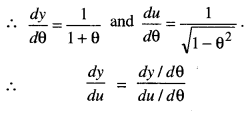
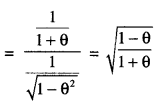
Question 9.
If y = xx , find \(\frac{d y}{d x}\).
Solution:
Here y = xx …(1)
Taking logs., log y = log xx
⇒ log y = x log x.
Differentiating w.r.t. x, we get:
\(\frac{1}{y} \cdot \frac{d y}{d x}\) = x \(\frac{1}{x}\) + logx.(1)
= 1 + log x.
Hence, \(\frac{d y}{d x}\) = y (1 + log x) dx
= xx (1 + log x). [Using (1)]
Question 10.
If y = \(\sqrt{2^{x}+\sqrt{2^{x}+\sqrt{2^{x}+\ldots \ldots+0 \infty}}}\) then prove that: (2y – 1)\(\frac{d y}{d x}\) = 2x log 2.
Solution:
The given series can be written as :
y = \(\sqrt{2^{x}+y}\)
Squaring, y2 = 2x + y
⇒ y2 – y = 2x.
Diff. w.r.t. x, (2y -1)\(\frac{d y}{d x}\) = 2x log 2.
Question 11.
Discuss the applicability of Rolle’s Theorem for the function f(x) = (x- 1)2/5 in the interval [0, 3].
Solution:
Since f(x) is a polynomial in x,
∴ it is continuous in [0, 3].
And f'(x) = \(\frac { 2 }{ 5 }\)(x-1) -3/5 = \(\frac{2}{5} \cdot \frac{1}{(x-1)^{3 / 5}}\)
which does not exist at x = 1
⇒ f(x) is not derivable in (0, 3).
Hence, Rolle’s theorem is not applicable.
Continuity and Differentiability Important Extra Questions Short Answer Type
Question 1.
Discuss the continuity of the function : f(x) = |x| at x = 0. (N.C.E.R.T.)
Solution:
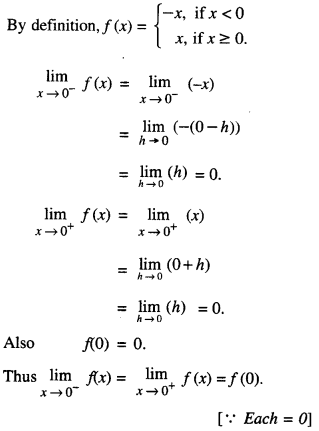
Hence ‘f’ is continuous at x = 0.
Question 2.
If f(x) = x + 1, find \(\frac{d}{d x}\)(fof)(x). (C.B.S.E. 2019)
Solution:
We have : f(x) = x + 1 …(1)
∴ fof(x) = f (f(x)) =f(x)+ 1
= (x + 1) + 1 = x + 2.
∴ \(\frac{d}{d x}\)(fof)(x).) = \(\frac{d}{d x}\)(x + 2) = 1 + 0 = 1.
Question 3.
Differentiate \(\tan ^{-1}\left(\frac{\cos x-\sin x}{\cos x+\sin x}\right)\) with respect to x. (C.B.S.E. 2018 C)
Solution:
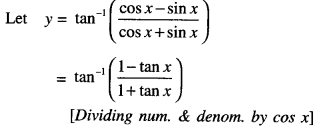
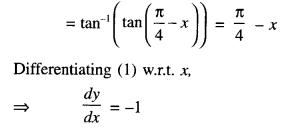
Question 4.
Differentiate: tan-1 \(\left(\frac{1+\cos x}{\sin x}\right)\) with respect to x. (C.B.S.E. 2018)
Solution:
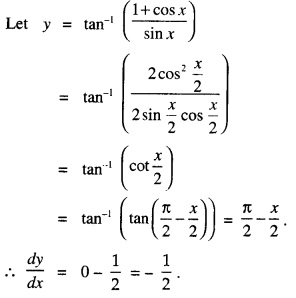
Question 5.
Write the integrating factor of the differential equation :
(tan-1 y – x) dy = (1 + y2) dx. (C.B.S.E. 2019 (Outside Delhi))
Solution:
The given differential equation is :
(tan-1 y – x) dy = (1 + y2) dx
⇒ \(\frac{d x}{d y}+\frac{x}{1+y^{2}}=\frac{\tan ^{-1} y}{1+y^{2}}\) Linear Equation
∴ I.F = \(e^{\int \frac{1}{1+y^{2}} d x}=e^{\tan ^{-1} y}\)
Question 6.
Find \(\frac{d y}{d x}\) if y = sin-1\(\left[\frac{5 x+12 \sqrt{1-x^{2}}}{13}\right]\) (A.I.C.B.S.E. 2016)
Solution:

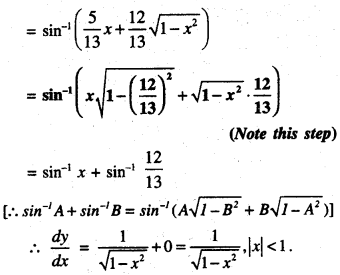
Question 7.
Find \(\frac{d y}{d x}\) if y = \(\sin ^{-1}\left[\frac{6 x-4 \sqrt{1-4 x^{2}}}{5}\right]\) (A.I.C.B.S.E. 2016)
Solution:
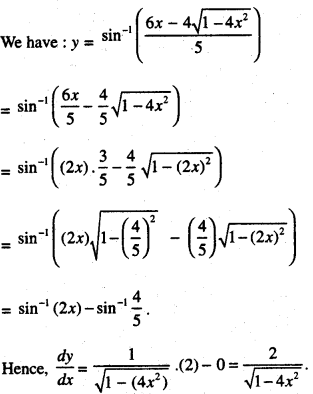
Question 8.
If y = {x + \(\sqrt{x^{2}+a^{2}}\)}n , prove that \(\frac{d y}{d x}=\frac{n y}{\sqrt{x^{2}+a^{2}}}\)
Solution:
y = {x + \(\sqrt{x^{2}+a^{2}}\)}n ……… (1)
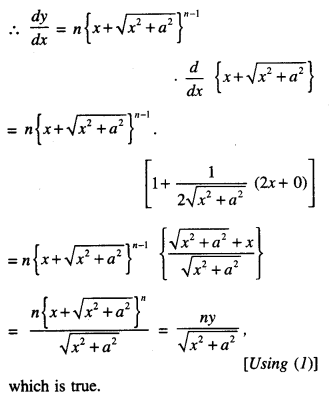
Question 9.
The total cost C(x) associated with the production of ‘x’ units of an item is given by C(x) = 0.005x3 – 0.02x2 + 30x + 5000.
Find the marginal cost when 3 units are produced, where by marginal cost we mean the instantaneous rate of change of the total cost at any level of output. (C.B.S.E. 2018)
Solution:
We have: 0.005x3 – 0.02x2 + 30x + 5000
∴ Marginal cost,
C'(x) = (0.005)(3x2) – 0.02(2x) + 30.
Hence,C'(3) = (0.005) (3×9)- (0.02) (6) + 30
= 0.135-0.12 + 30
= 30.135 – 0.12
= 30.02 units nearly
Question 10.
If (x2 + y2)2 = xy, find \(\frac{d y}{d x}\). (C.B.S.E. 2018)
Solution:
We have : (x2 + y2)2 = xy
Diff. w.r.t. x,
2(x2 + y2)\(\frac{d}{d x}\)(x2+ y2) = x\(\frac{d y}{d x}\) + y(1)
2(x2 + y2) [2x +2y\(\frac{d y}{d x}\) ] = x\(\frac{d y}{d x}\) + y
4x(x2 + y2) – y = \(\frac{d y}{d x}\) [x – 4y(x2 + y2)]
Hence \(\frac{d y}{d x}=\frac{4 x^{3}+4 x y^{2}-y}{x-4 y x^{2}-4 y^{3}}\)
Question 11.
Fing \(\frac{d y}{d x}\) if x2/3 + y2/3 = a2/3 (N.C.E.R.T)
Solution:
The given equation is
if x2/3 + y2/3 = a2/3
Its parametric equations are :
x = a cos3 θ,
y = a sin3 θ
[x2/3 + y2/3 = a2/3 (cos2θ + sin2θ) = a2/3(I) = a2/3]
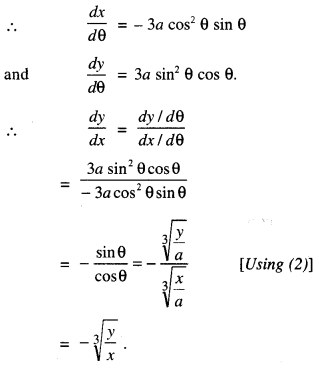
Question 12.
Find the value of \(\frac{d y}{d x}\) at θ = \(\frac{\pi}{4}\), if:
x = aeθ (sin θ – cos θ)
and y = aeθ (sin θ + cos θ). (A.I.C.B.S.E. 2014)
Solution:
We have : x= aeθ (sin θ – cos θ)
and y= aeθ(sin θ + cos θ).
\(\frac{d x}{d \theta}\) = aeθ (cos θ + sin θ) + aeθ(sin θ – cos θ)
= 2aeθsin θ
and \(\frac{d y}{d \theta}\) = aeθ (cos θ – sin θ) + aeθ(sinθ + cosθ)
= 2aeθ cos θ
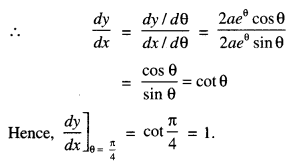
Question 13.
If x = a(2θ – sin 2θ) and y = a(1 – cos 2θ), find \(\frac{d y}{d x}\) where θ = \(\frac{\pi}{3}\) (C.B.S.E 2018)
Solution:
We have :
x = a(2θ – sin 2θ)
and y = a(1 – cos 2θ).
∴ \(\frac{d x}{d \theta}\) = a(2 – 2 cos 2θ)
and \(\frac{d y}{d \theta}\) = a(0 + 2 sin 2θ) = 2a sin 2θ.

Question 14.
Find f’ (x), if f(x) = (sin x)sin x for all 0 < x < π. (N.C.E.R.T.)
Solution:
We have :
f(x) = (sin x)sin x …(1)
Taking logs., log f(x) = log (sin x)sin x
⇒ log f(x) = sin x log (sin x).
Diff. w.r.t. x,
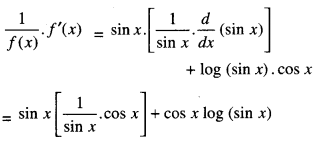
= cos x (1 + log sin x)
⇒ f’ (x) = f(x) cos x (1 + log sin x).
Hence ,f'(x) = (sin x)sin xcos x (1 + log sin x).
[Using (i)]
Question 15.
If x16 y9 = (x2 + y)17, prove that \(\frac{d y}{d x}=\frac{2 y}{x}\) (C.B.S.E. (F) 2012)
Solution:
We have :
x16 y9 = (x2 + y)17.
Taking logs.,
log (x16 y9) = log (x2 + y)17
⇒ 16 log x + 9 log y = 17 log (x2 + y).
Diff. w.r.t. x,

Question 16.
If y = ae2x + be-x, then show that \(\frac{d^{2} y}{d x^{2}}-\frac{d y}{d x}-2 y=0\) (C.B.S.E. Sample Paper 2019-20)
Solution:
Here,
y = ae2x + be-x ……… (1)
∴ \(\frac{d y}{d x}\) = 2ae2x – be-x …….. (2)
And \(\frac{d^{2} y}{d x^{2}}\) = 4ae2x + be-x ……….. (3)
Now, \(\frac{d^{2} y}{d x^{2}}-\frac{d y}{d x}-2 y\)
= [4ae2x + be-x] – [2ae2x – be-x] – 2[ae2x + be-x] [Using (1), (2) & (3)]
= 4ae2x + be-x – 2ae2x + be-x – 2ae2x – 2be2x = 0.
Question 17.
If y = log(1 + 2t2 + t4), x = tan-1t, find \(\frac{d^{2} y}{d x^{2}}\) (C.B.S.E. Sample Paper 2018-19)
Solution:
We have : y = log(1 + 2t2 + t4)
⇒ y = log (1 + t2)2
⇒ y = 21og (1 + t2).

Question 18.
If x sin (a + y) + sin a cos (a + y) = 0, then prove that: \(\frac{d y}{d x}=\frac{\sin ^{2}(a+y)}{\sin a}\) (A.I.C.B.S.E. 2013)
Solution:
We have :
x sin (a + y) + sin a cos (a + y) = 0 …(1)
⇒ x = \(-\frac{\sin a \cos (a+y)}{\sin (a+y)}\) …..(2)
Diff (1) w.r.t x,
x cos (a + y)(0+\(\frac{d y}{d x}\) ) + sin (a + y). 1 + sina(-sin(a+y))(0+\(\frac{d y}{d x}\)) = 0
(xcos(a + y) – sin a sin (a + y)] \(\frac{d y}{d x}\) = – sin (a + y)

⇒ – sin (a + y) [Using (2)]
⇒ -sin a[cos2(a+y)+sin2(a+y)] \(\frac{d y}{d x}\) = -sin2 (a+y)
⇒ -sin a(1) \(\frac{d y}{d x}\) = = -sin2 (a+y)
Hence \(\frac{d y}{d x}\) = \(\frac{\sin ^{2}(a+y)}{\sin a}\)
Which is true.
Question 19.
If sin y = x cos (a + y), then show that \(\frac{d y}{d x}=\frac{\cos ^{2}(a+y)}{\cos a}\) Also, show that \(\frac{d y}{d x}\) = cos a, when x = 0. (C.B.S.E. 2018C)
Solution:
Given, sin y = x cos (a + y)
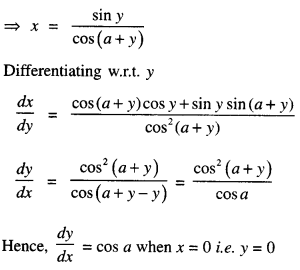
Question 20.
Find the value of ‘c’ in Rolle’s Theorem for the function f (x) = x3 – 3x in [-√3, 0]. (A.1.C.B.S.E. 2017)
Solution:
We have : f(x) = x3 – 3x.
(i) f(x) is continuous in [-√3, 0].
[∵ f(x) is a polynomial in x]
(ii) f'(x) = 3x2 – 3 …(1)
∴ f'(x) exists for each x in (-√3,0)
(iii) f(-√3) = (-√3)3 – 3(-√3)
= -3√3 + 3√3 = 0
f(0) = 0 – 0 = 0.
∴ f(-√3) =f(0).
Thus all the conditions of Rolle’s Theorem are satisified.
∴ There exists at least one number ‘c’ between – √3 and 0 such that f'(c) = 0.
But f'(c) = 3c2 – 3. [Putting x – c in (1)
∴ f'(c) = 0
3c2 – 3 = 0
c2 = 1
c = ± 1.
c = – 1 ∈ (-√3,0).
Hence, Rolle’s Theorem is verified and c = – 1.
Question 21.
Find a point on the parabola y = (x – 3)2, where the tangent is parallel to the chord joining (3, 0) and (4,1).
Solution:
We have : y = f(x) = (x – 3)2.
We discuss the applicability of L.M.V. Theorem in [3, 4],
(i) fix) is continuous in [3, 4],
[ ∵ f(x) is a polynomial]
(ii) f'(x) = 2(x – 3), which exists for all x ∈ (3,4).
∴ f(x) is derivable in (3, 4).
Thus both the conditions of Lagrange’s Mean Value Theorem are satisfied.
∴ There exists at least one number c ∈ (3, 4) such that
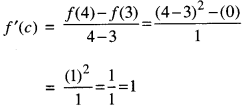
⇒ 2(c – 3) = 1
⇒ 2c = 1
⇒ c = \(\frac{7}{2}\) ∈ (3, 4).
When x = \(\frac{7}{2}\), then y = (\(\frac{7}{2}\) – 3)2 = 1/4
Hence, the required point is ( \(\frac{7}{2}, \frac{1}{4}\) )
Continuity and Differentiability Important Extra Questions Long Answer Type 1
Question 1.
Find the value of ‘a’ for which the function ‘f’ defined as :
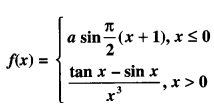
is continuous at x =0 (CBSE 2011)
Solution:

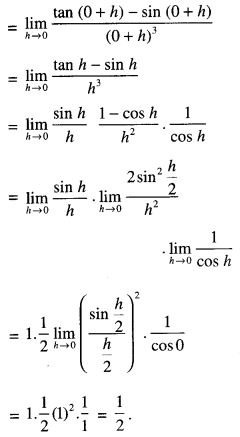
Also f(0) = a sin π/2 (0+1)
= a sin π/2 = a(1) = a
For continuity,
\(\lim _{x \rightarrow 0^{-}} f(x)=\lim _{x \rightarrow 0^{+}} f(x)=f(0)\)
⇒ a = 1/2 = a
Hence, a = 1/2
Question 2.
Find the values of ‘p’ and ‘q’ for which :

is continuous at x = 2 (CBSE 2016)
Solution:
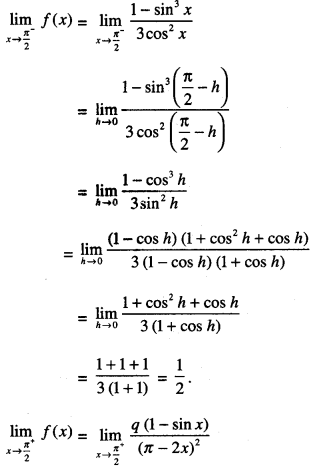
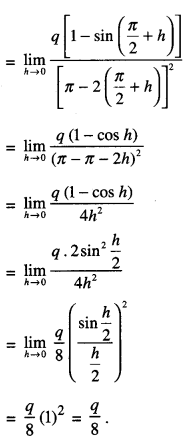
Also f(\(\frac{\pi}{2},\)) = p
For continuity \(\lim _{x \rightarrow \frac{\pi^{-}}{2}} f(x)=\lim _{x \rightarrow \frac{\pi^{*}}{2}} f(x)\)
= f(\(\frac{\pi}{2},\))
⇒ \(\frac{1}{2}=\frac{q}{8}\) = p
Hence p = 1/2 and q = 4
Question 3.
Find the value of ‘k’ for which
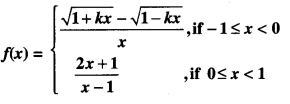
is continuous at x = 0 (A.I.C.B.S.E. 2013)
Solution:


For continuity \(\lim _{x \rightarrow 0^{-}} f(x)=\lim _{x \rightarrow 0^{+}} f(x)=f(0)\)
⇒ k = -1 = -1
Hence k = -1
Question 4.
For what values of ‘a’ and ‘b\ the function ‘f’ defined as :

is continuous at x = 1. (CBSE 2011)
Solution:
\(\lim _{x \rightarrow 1^{-}} f(x)=\lim _{x \rightarrow 1^{-}}\) (3ax +b)
= \(\lim _{h \rightarrow 0}\) (3a (1-h) + b]
= 3a(1 – 0) + b
= 3a + b
\(\lim _{x \rightarrow 1^{+}} f(x)=\lim _{x \rightarrow 1^{+}}(5 a x-2 b)\)
= \(\lim _{h \rightarrow 0}\) [5a (1+h) – 2b]
= 5a (1+0) – 2b
= 5a – 2b
Also f(1) = 11
Since ‘f’ is continuous at x = 1,
∴ \(\lim _{x \rightarrow 1^{-}} f(x)=\lim _{x \rightarrow 1^{+}} f(x)\)= f(1)
⇒ 3a + b = 5a – 2b = 11.
From first and third,
3a + b = 11 …………… (1)
From last two,
5a – 2b = 11 …………… (2)
Multiplying (1) by 2,
6a + 2b = 22 ………….. (3)
Adding (2) and (3),
11a = 33
⇒ a = 3.
Putting in (1),
3(3) + b = 11
⇒ b = 11 – 9 = 2.
Hence, a = 3 and b = 2.
Question 5.
If f(x) , defined by the following is continuous at x = 0, find the values of a, b, and c.
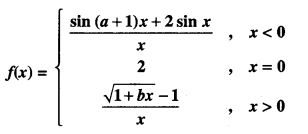
(A.I.C.B.S.E 2011)
Solution:
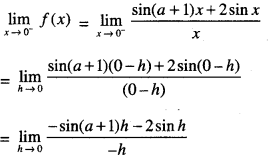
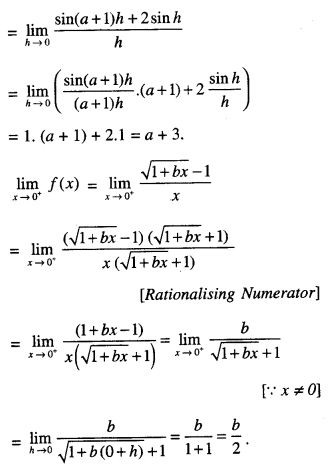
Also f(0) = 2
Since f(x) is continuous at x = 0,
∴ \(\lim _{x \rightarrow 0^{-}} f(x)=\lim _{x \rightarrow 0^{+}} f(x)=f(0)\)
⇒ a + 3 = b/2 = 2
Hence,a = -1 and b = 4.
Question 6.
Find ‘a’ and ‘b’, if the function given by :
f(x) = \(\left\{\begin{array}{ll}
a x^{2}+b, & \text { if } x<1 \\ 2 x+1, & \text { if } x \geq 1 \end{array}\right.\) is differentiable at x = 1. (C.B.S.E. Sample Paper 2018)
Solution:
Since ‘f’ is derivable at x = 1, ∴ ‘f’ is continuous at x = 1 im 33 => a + b = 2 + 1 = 3
⇒ a + b = 3 …………. (1)
Again since ‘f is differentiable at x = 1
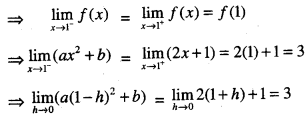
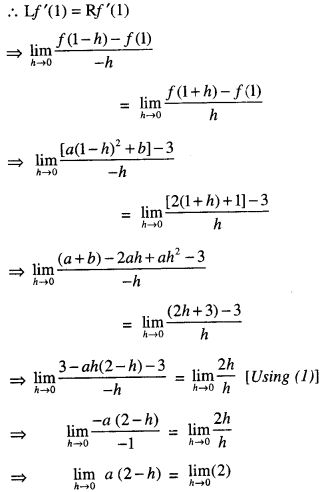
2a = 2
Putting in (1),
1 + b = 3
⇒ b = 3 – 1
⇒ b = 2.
Hence, a = 1 and b = 2.
Question 7.
Prove that: \(\frac{d}{d x}\left[\frac{x}{2} \sqrt{a^{2}-x^{2}}+\frac{a^{2}}{2} \sin ^{-1} \frac{x}{a}\right]\) = \(\sqrt{a^{2}-x^{2}}\)
(C.B.S.E. (F) 2011)
Solution:

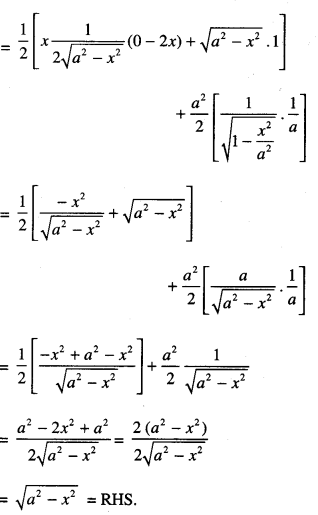
Question 8.
Differentiate \(\sin ^{-1}\left(\frac{2^{x+1}}{1+4^{x}}\right)\) w.r.t x (N.C.E.R.T)
Solution:
Let y = \(\sin ^{-1}\left(\frac{2^{x+1}}{1+4^{x}}\right)\)
= \(\sin ^{-1}\left(\frac{2.2^{x}}{1+\left(2^{x}\right)^{2}}\right)\)
Put 2x = tan θ
so that θ = tan-1(2x) ………… (1)
Then y = \(\sin ^{-1}\left(\frac{2 \tan \theta}{1+\tan ^{2} \theta}\right)\)
= sin-1 (sin 2θ)
= 2θ = 2tan-1(2x).
[Using (1)]
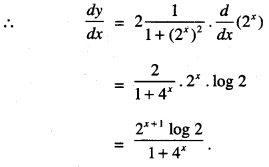
Question 9.
If log (x2 + y2) = 2 tan-1 [ y/x] show that : \(\frac{d y}{d x}=\frac{x+y}{x-y}\) (C.B.S.E. 2019)
Solution:
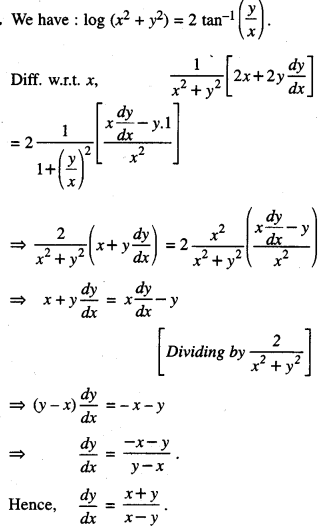
Question 10.
If y = tan-1\(\left(\frac{\sqrt{1+x^{2}}+\sqrt{1-x^{2}}}{\sqrt{1+x^{2}}-\sqrt{1-x^{2}}}\right)\), x2 ≤ 1, then find \(\frac{d y}{d x}\)
We have : log (x2 + y2) = 2 tan-1 (A.I.C.B.S.E. 2015)
Solution:

Question 11.
Differentiate the following with respect to x = sin-1\(\left(\frac{2^{x+1} \cdot 3^{x}}{1+(36)^{x}}\right)\) (A.I.C.B.S.E. 2013)
Solution:
= sin-1\(\left(\frac{2^{x+1} \cdot 3^{x}}{1+(36)^{x}}\right)\)
= sin-1\(\left(\frac{2.2^{x} \cdot 3^{x}}{1+(6)^{2 x}}\right)\)
= sin-1\(\left(\frac{2.6^{x}}{1+(6)^{2 x}}\right)\)
Put 6x = tan θ
So that θ = tan-1(6x) …………(1)
Then y = sin-1( \(\left(\frac{2 \tan \theta}{1+\tan ^{2} \theta}\right)\) )
= sin-1(sin 2θ)
= 2θ = 2tan-1(6x) [Using (1)]
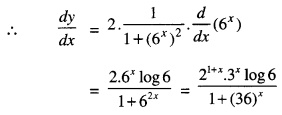
Question 12.
Differentiate : tan-1\(\left[\frac{\sqrt{1+x^{2}}-\sqrt{1-x^{2}}}{\sqrt{1+x^{2}}+\sqrt{1-x^{2}}}\right]\) w.r.t cos-1 x2 (C.B.S.E. Outside Delhi 2019)
Solution:
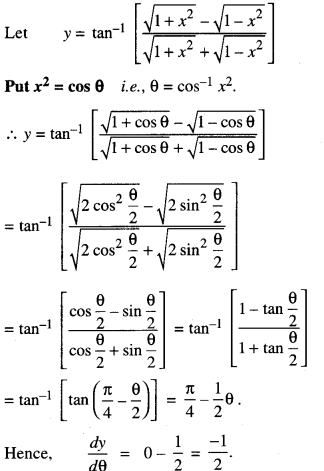
Question 13.
If xy – yx = ab, find \(\frac{d y}{d x}\). (Delhi 2019)
Solution:
We have : xy – yx = ab
Putting xy = u and yx = v, we get:
u – v = ab
so that, \(\frac{d u}{d x}-\frac{d v}{d x}\) =0 ………….(1)
Now, u = xy
Taking logs.,
log u = log xy
⇒ log u = y log x.
Diff. w.r.t. x,
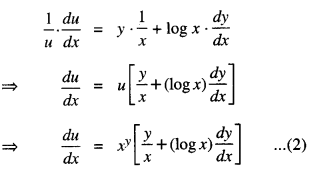
And, v = yx
Taking logs., log v = log yx
⇒ log v = x log y.
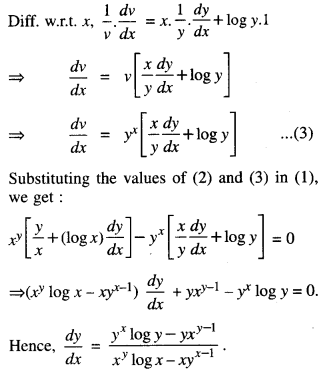
Question 14.
If y = (log x)x + xlogx, find \(\frac{d y}{d x}\) (C.B.S.E. 2019)
Solution:
Let y = (log x)x + xlogx = u + v,
where u = (log x)x and v = xlogx
∴ \(\frac{d y}{d x}=\frac{d u}{d x}+\frac{d v}{d x}\) ……….(1)
Now, u = (log x)x
so that log u = x log (log x).
Diff. w.r.t. x,
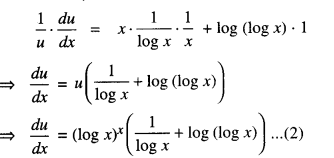
Again, v = xlogx
so that log v = log x. log x = (logx)2
Diff w.r.t x,

Question 15.
If \(\sqrt{1-x^{2}}+\sqrt{1-y^{2}}=a(x-y)\) then prove that \(\frac{d y}{d x}=\frac{\sqrt{1-y^{2}}}{\sqrt{1-x^{2}}}\) (C.B.S.E. Sample Paper 2019-20)
Solution:
We have: \(\sqrt{1-x^{2}}+\sqrt{1-y^{2}}=a(x-y)\)
Putting x = sin A and y = sin B, we get:
\(\sqrt{1-\sin ^{2} \mathrm{~A}}+\sqrt{1-\sin ^{2} \mathbf{B}}=a\)= a (sin A – sin B) ⇒ cos A + cos B = a (sin A – sin B)
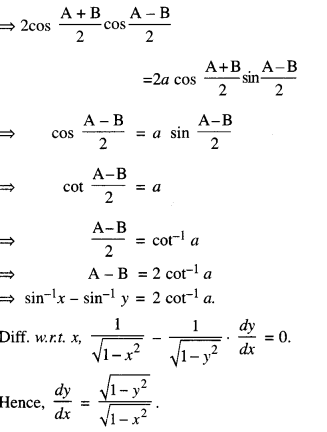
Question 16.
If x = a sec3 θ and y = a tan3θ, find \(\frac{d^{2} y}{d x^{2}}\)
Solution:
Given : x = a sec3 θ
y = a tan3θ

Question 17.
Find \(\frac{d y}{d x}\), if xy. yx = xx. (C.B.S.E 2018C)
Solution:
We have: xy yx = xx.
Taking logs.,log xy yx = log xx
⇒ y log x + x log y=x log x
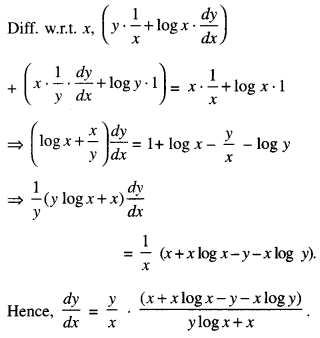
Question 18.
Find \(\frac{d y}{d x}\) if yx + xy + xx = ab (N.C.E.R.T. A.I.C.B.S.E.2015)
Solution:
We have: yx + xy + xx
Putting yx = u. xy = v and xx = w, we get:
u + y + w = ab
Diff. w.r.t. x, \(\frac{d u}{d x}+\frac{d v}{d x}+\frac{d w}{d x}\) = 0 …………… (1)
Now u = yx ………….(2)
Taking logs., log u = log yx
log u = x log y.
Diff. w.r.t. x,

And v = xy
Taking logs., log v = log xy
log v = y log x.
Diff. w.r.t. x,

[using (4)]
Lastly w = xx
Taking logs.,
log w = xlog x
∴ \(\frac{d w}{d x}\) = x (1+log x) …………. (7)
From (1) , using (3), (5) and (7), we get:
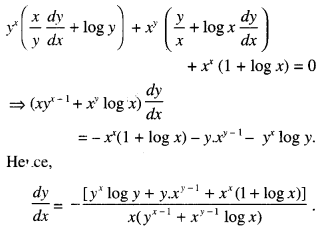
Question 19.
If y = etan-1 x, prove that:\(\left(1+x^{2}\right) \frac{d^{2} y}{d x^{2}}+(2 x-1) \frac{d y}{d x}=0\)
(C.B.S.E. 2018C)
Solution:
Given: y = etan-1x,
Differentiating w.r.t. x
\(\frac{d y}{d x}=e^{\ln ^{-1} x}\left(\frac{1}{1+x^{2}}\right)=\frac{y}{1+x^{2}}\)
Agian differentiating w.r.t. x
(1 + x2)\(\frac{d y}{d x}\) = y
(1 + x2)\(\frac{d^{2} y}{d x^{2}}\) + 2x \(\frac{d y}{d x}\) = \(\frac{d y}{d x}\)
(1 + x2)\(\frac{d^{2} y}{d x^{2}}\) + (2x – 1) \(\frac{d y}{d x}\) = 0
Question 20.
If x cos (a + y) = cos y, then prove that:
\(\frac{d y}{d x}=\frac{\cos ^{2}(a+y)}{\sin a}\)
Hence show that :
sin a \(\frac{d^{2} y}{d x^{2}}\) + sin 2(a + y)\(\frac{d y}{d x}\) = 0
Solution:
We have : x cos (a + y) = cos y …………(1)
x = \(\frac{\cos y}{\cos (a+y)}\) …………..(2)
Diff. (I) w.r.t. x,
-x sin (a + y) (0 + \(\frac{d y}{d x}\) ) + cos (a + y) .1
⇒ -sin y.\(\frac{d y}{d x}\)
⇒ (xsin(a+y) – siny)\(\frac{d y}{d x}\) = cos(a +y)
⇒ (\(\frac{\cos y}{\cos (a+y)}\) sin (a+y) – sin y)\(\frac{d y}{d x}\)
⇒ cos (a + y) [Using (2)]
(sin (a + y) cos y – cos (a + y) sin y)\(\frac{d y}{d x}\)
⇒ cos2 (a + y)
⇒ sin (a + y – y) \(\frac{d y}{d x}\) = cos2(a+y)
\(\frac{d y}{d x}\) = \(\frac{\cos ^{2}(a+y)}{\sin a}\)
which is true.
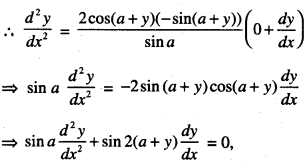
Question 21.
If y = (sin-1 x)2, prove that:
\(\left(1-x^{2}\right) \frac{d^{2} y}{d x^{2}}-x \frac{d y}{d x}-2=0\) (C.B.S.E. 2019)
Solution:
We have y = (sin-1 x)2
∴ y1 = 2(sin-1 x). \(\frac{1}{\sqrt{1-x^{2}}}\)
⇒ \(\sqrt{1-x^{2}} \cdot y_{1}\) = 2(sin-1 x).
Squaring, (1 – x2) y12 = 4(sin-1 x)2
⇒ (1 – x2) y12 = 4y [Using (1)]
Diff. w.r.t x,
(1 – x2) 2y1y2 + (-2x) y12 = 4y1
⇒ (1 – x2) y2 – xy1 = 2 [Dividing by 2y1 ]
Hence, (1-x2)\(\frac{d^{2} y}{d x^{2}}\) – x\(\frac{d y}{d x}\) – 2 = 0.
Question 22.
If y = cos (m cos-1 x), show that
(a – x2)\(\frac{d^{2} y}{d x^{2}}\) – x\(\frac{d y}{d x}\) + m2y = 0 (C.B.S.E. Sample Paper 2018-2019)
Solution:
We have :
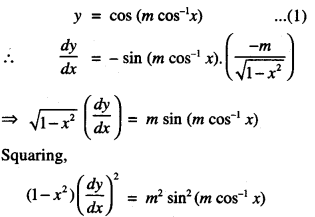
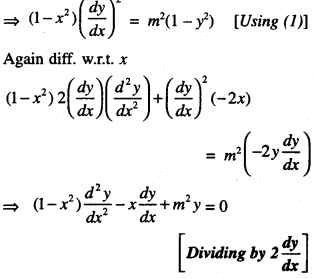
Question 23.
If y = sin (sin x), prove that
\(\frac{d^{2} y}{d x^{2}}\) + tanx \(\frac{d y}{d x}\) + y cos2x = 0. (C.B.S.E. 2018)
Solution:
We have :
y = sin (sin x)
∴ \(\frac{d y}{d x}\) = cos (sin x) . cos x ……(2)
and \(\frac{d^{2} y}{d x^{2}}\) = cos (sin x) (- sin x) + cos x [- sin (sin x). cos x]
= – sin x cos (sin x) – cos2x sin (sin x) …(3)
:. LHS = \(\frac{d^{2} y}{d x^{2}}\) + tan x \(\frac{d y}{d x}\) + y cos2 x
⇒ – sin x cos (sin x) – cos2 x sin (sin x) + tan x cos (sin x).cos x + sin (sin x) cos2 x
[Using (1). (2) and (3)]
⇒ – sin x cos (sin x) – cos2 x sin (sin x) + sin x cos (sin x) + cos2 x sin (sin x)
⇒ – sin x cos (sin x) + sin x cos (sin x)
= 0 = RHS.
Question 24.
If x = sin t, y = sin pt, prove that:
(1 – x2)\(\frac{d^{2} y}{d x^{2}}\) – x \(\frac{d y}{d x}\) + p2y = 0
(Outside Delhi 2019)
Solution:
We have : x = sin t
and y = sin pt.
\(\frac{d y}{d x}\) = cos t
and \(\frac{d y}{d x}\) = p cos pt
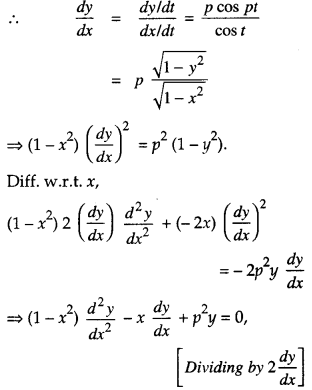
which is true.
Question 25.
Find \(\frac{d y}{d x}\), if xy.yx = xx. (C.B.S.E. 2019 C)
Solution:
We have: xy.yx = xx
Taking logs., logxy yx = log xx
⇒ y log x + x log y = x log x
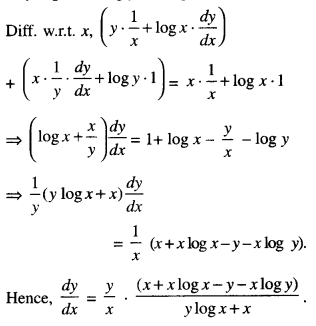
Question 26.
If y = xx, prove that
\(\frac{d^{2} y}{d x^{2}}-\frac{1}{y}\left(\frac{d y}{d x}\right)^{2}-\frac{y}{x}=0\) (C.B.S.E. 2016,14)
Solution:
We have : y = xx.
Taking logs.,
log y = x log x.
Duff. w.r.t. x,
\(\frac{1}{y} \cdot \frac{d y}{d x}\) = x. \(\frac{1}{y}\) + log x.1
\(\frac{d y}{d x}\) = y(1+1ogx) ………….(1)
Again duff. w.r.t. x,
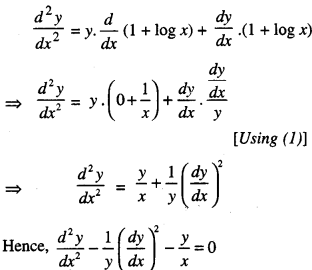
Question 27.
If x = a (cos 2θ + 2θ sin 2θ) andy = a (sin 2θ – 2θ cos 2θ), find \(\frac{d^{2} y}{d x^{2}}\) at θ = \(\frac{\pi}{8}\)
(C.B.S.E. Sample Paper 2019-20)
Solution:
We have: x – a (cos 2θ + 2θ sin 2θ)
∴ \(\frac{d x}{d \theta}\) = a (- 2 sin 2θ + 2 sin 2θ + 4θ cos 2θ).
⇒ \(\frac{d x}{d \theta}\) = 4aθ cos 2θ ………..(1)
And y = a (sin 2θ – 2θ cos 2θ).
∴ \(\frac{d y}{d \theta}\) = a (2 cos 2θ + 4θ sin 2θ – 2 cos 2θ)
\(\frac{d y}{d \theta}\) = 4aθsin 2θ ………….. (2)
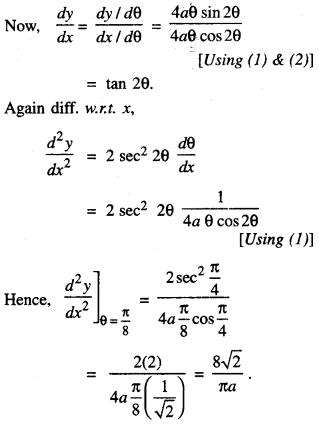
Question 28.
If x = cos t + log tan (t/2) y = sin t , then find the values of \(\frac{d^{2} y}{d t^{2}}\) and \(\frac{d^{2} y}{d x^{2}}\) at t = \(\frac{\pi}{4}\)
(C.B.S.E. 2019 Delhi Set-II)
Solution:
We have x = cos t log tan (t/2) and
y = sin t
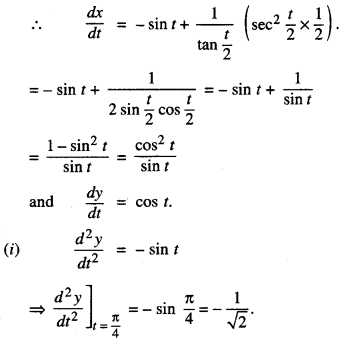
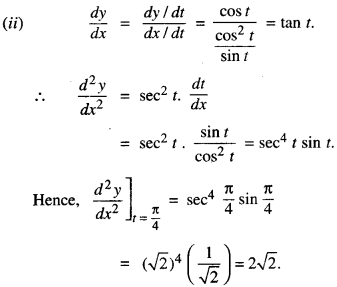
Question 29.
If y = a cos (log x) + b sin (log x), show that:
\(x^{2} \frac{d^{2} y}{d x^{2}}+x \frac{d y}{d x}+y=0\) (C.B.S.E. 2019C)
Solution:
We have:
y = a cos (log x) + b sin (log x) …..(1)
\(\frac{d y}{d x}\) = – a sin (log x) \(\frac{1}{x}\) + b cos (log x) \(\frac{1}{x}\)
x\(\frac{d y}{d x}\) = -asin (log x) + b cos (log x).
Again diff. w.r.t.x., \(x \frac{d^{2} y}{d x^{2}}+\frac{d y}{d x} \cdot 1\)
= – a cos (log x) . \(\frac{1}{x}\) – b sin (log x) . \(\frac{1}{x}\)
\(x^{2} \frac{d^{2} y}{d x^{2}}+x \frac{d y}{d x}\)
= – [a cos (log x) + b sin (log x)]
= -y. [Using (1)]
Hence, \(x^{2} \frac{d^{2} y}{d x^{2}}+x \frac{d y}{d x}+y=0\)
Question 30.
Use Lagrange’s Theorem to determine a point P on the curve f(x) = \(\sqrt{x-2}\), defined in the interval [2, 3], where the tangent is parallel to the chord joining the end points on the curve.
Solution:
We have y = f(x) = \(\sqrt{x-2}\) …….(1)
∴ f'(x) = \(\frac{1}{2 \sqrt{x-2}}\)
now f(a) = f(2) = \(\sqrt{2-2}=\sqrt{0}\) = 0
and f(b) = f(3) = \(\sqrt{3-2}=\sqrt{1}\) = 1.
By Lagrange’s Theorem, we have :
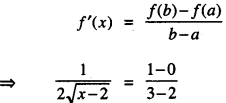
⇒ \(\frac{1}{4(x-2)}\) = 1 [Squaring both
⇒ 1 = 4x – 8
⇒ 4x = 9
⇒ x = \(\frac{9}{4}\) ∈ (2, 3).
Putting in (1), y = \(\sqrt{\frac{9}{4}-2}=\sqrt{\frac{1}{4}}=\frac{1}{2}\)
Hence, ( \(\frac{9}{4}, \frac{1}{2}\) ) is the reqd. point.